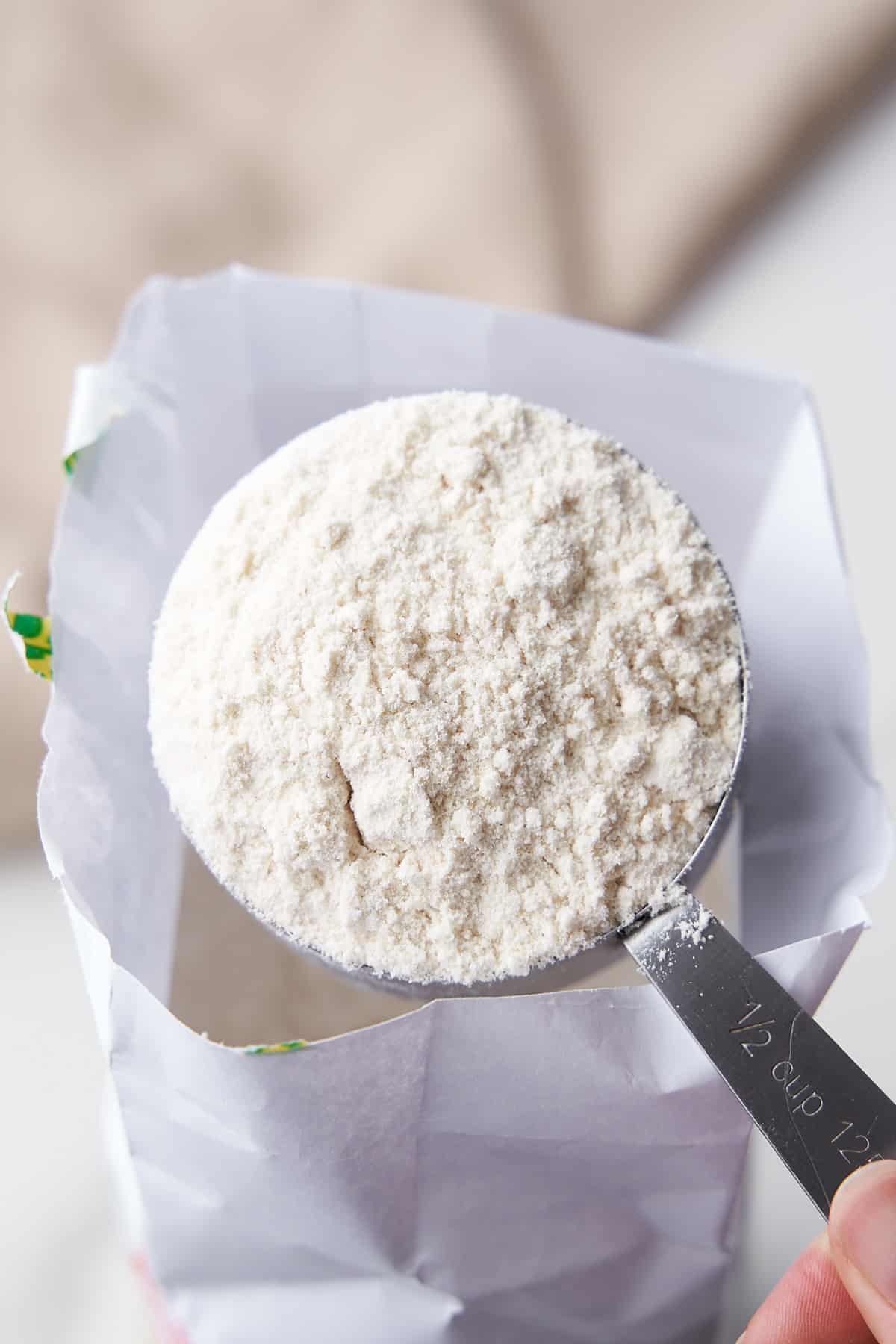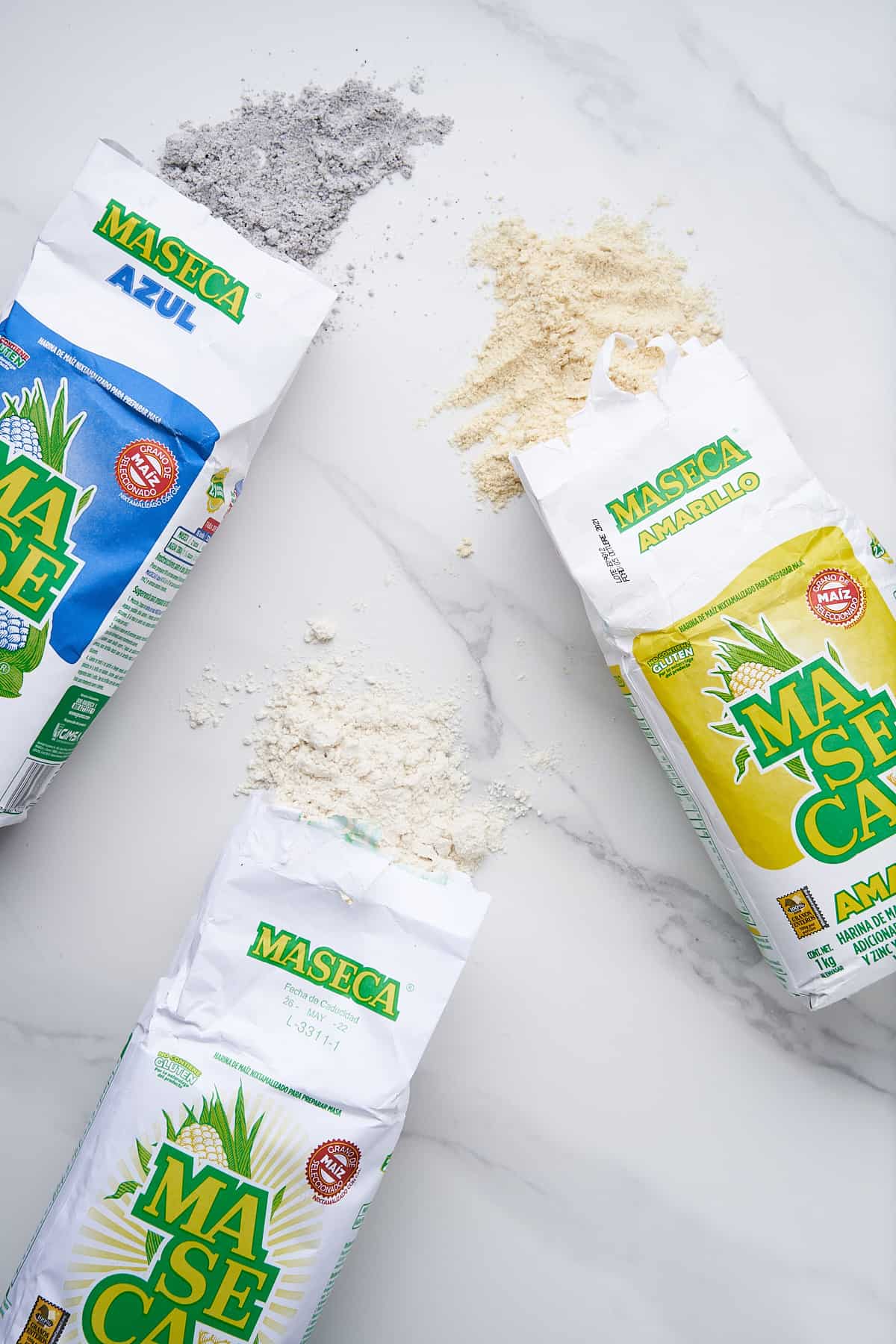What is Masa Harina?
Masa harina is a staple ingredient in Mexican and Latin American cuisine. This guide covers everything you need to know, including what it is, where to buy it, and how to use it in recipes.

What is masa harina?
In English, “masa harina” translates to “dough flour.” More specifically, it’s a special type of flour made from dried corn kernels that have undergone a process called nixtamalization.
Corn kernels are mixed in an alkaline solution (usually calcium hydroxide), then they’re boiled for an hour and steeped for 6-12 hours. They’re rinsed and ground with a molinito before being dried into flour.
Of the five common types of corn, dent, flour, and flint are the ones that are most often used. There are both commercial and heirloom varieties of each one.
The most well-known masa harina is blanco (white), but you can also find azul (blue), amarillo (yellow), rosado (pink), etc. The differences in color indicate the variety of corn used in the process.

Flavor profile
On its own, masa harina has a rather sour, tangy, and unpleasant flavor. However, once you cook it, the smooth, sweet, and nutty flavors that are characteristic of Mexican cuisine become prominent.
Yellow masa harina has a strong corn flavor with a subtle sweetness. This variety forms quite sturdy tortillas, so use it in recipes that call for frying.
White masa harina tastes nutty, sweet, and delicate. Tortillas made from this type have a softer texture and are great for tacos. Blue masa harina provides a sweeter, nuttier, and more rustic flavor than white or yellow masa harina.
How to use it
There are many ways to incorporate masa harina into recipes. The most common option is to reconstitute it with water and make masa for corn tortillas or blue corn tortillas.
Masa harina can also be used to thicken drinks like atole, vegan champurrado, and tejuino. It can even be mixed with chiles to make enchiladas potosinas or combined with vegetable shortening for vegan tamales.
Recipes
With so many flavor-packed Mexican recipes utilizing masa harina, I’ve included some of my favorite plant-based dishes for you to try:
Storing
You can keep your masa harina in its original packaging, but the best option is to store it in a sealed glass container.
It should be stored in a cool, dry place to prevent moisture and pests. Properly stored, it can last for up to a year. If you live in a particularly humid climate, try refrigerating it to extend its shelf life.
Buying guide
There are a variety of masa harina vendors, ranging from small-batch to mass-produced. Much like wine or coffee, the production process has a significant impact on the overall flavor and texture.
Most large grocery stores sell masa harina in their international, Latin American, or Mexican food aisle. If you’re lucky to live near a Mexican food market, you will certainly find it there.
One of the most iconic brands is Maseca, so it’s probably one of the easiest kinds to find in both grocery stores and online. If you want to test out some exceptional products, check out Masienda! They work with local farming communities in Oaxaca to produce heirloom corn and masa harina.

Substitutions
With a unique flavor profile and characteristics, masa harina can only be substituted under certain circumstances.
- Ground corn tortillas: To achieve the same flavor, try blending corn tortillas into a powder. Although you may achieve a similar flavor, this method should really only be used for thickening recipes because the texture won’t be the same.
- Cornstarch, cornflour, or cornmeal: If you’re using masa harina as a thickening agent in soups, stews, and drinks, cornstarch, cornflour, or cornmeal will work. However, you won’t end up with the same flavors as masa harina.
- Wheat flour: Like cornflour or cornmeal, wheat flour can also thicken certain dishes. Just keep in mind, this option is not gluten-free.
Frequently asked questions
Yes, masa harina is naturally gluten-free as it’s made from corn. However, if you’re celiac or highly sensitive to gluten, look for brands that certify their masa harina as gluten-free to avoid cross-contamination risks.
Cornmeal is simply dried and ground corn, without undergoing the lime treatment that masa harina does. This gives masa harina a unique flavor and chemical properties, making it ideal for making tortillas, tamales, and other Mexican and Central American dishes.
No, masa harina is not the same as polenta. Polenta is a variety of cornmeal and, therefore, it does not go through the nixtamalization process like masa harina.
Masa harina that has gone bad will have an off smell, a stale taste, and might even show signs of mold or bugs if moisture has entered the package. Always check your masa harina before using it if it’s been stored for a while.
Mitch Chapman is a food writer, photographer, and one of the founders of Broke Bank Vegan. With a background in healthcare and the restaurant industry, he has a passion for sharing healthy yet flavorful plant-based food.




